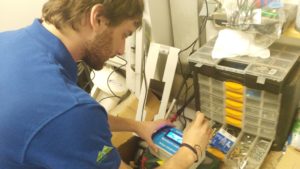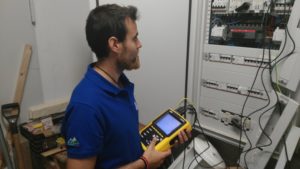Aragon Hydrogen Foundation’s Technicians visit the Bachimaña hut
On Wednesday, June 14, two technicians of the Aragon Hydrogen Foundation went to the refuge of Bachimaña to carry out activities framed in the project SUSTAINHUTS. The FHa colleagues measured the basal electricity consumption of the shelter as well as that of their main consumers (dishwashers and oven, both three-phase).
Another important consumer, especially in winter, are the electric heaters that the refuge has installed recently to take advantage to the maximum the energetic surplus that finds in winter in the hydraulic turbine.
Another important consumer, especially in winter, are the electric heaters that the refuge has installed recently to take advantage of the maximum energy surplus that the hut has in winter from the hydraulic turbine.

Installation Consumer Data Logger
During the visit, the technicians installed an equipment that will continuously record the electrical consumption in order to establish a reference that allows the sizing of the hydrogen cycle to be installed in that refuge. This hydrogen cycle is composed of an electrolyser for the generation of hydrogen with the energetic surplus of the hydraulic turbine, a storage system, and a fuel cell that will allow to supply electricity to the refuge thanks to the hydrogen stored when the water level of the reservoir Do not allow the turbine to operate (this situation is usually given a couple of months a year, between April and June, until the thaw starts). This approach will reduce the pollutant emissions of diesel groups that supply the energy to the shelter when the turbine can not operate due to water shortage in the reservoir, making the shelter more sustainable.

Measurement of power consumption.
In order to design all these elements, it is essential to know the daily consumption profile of the shelter. After a representative period of registration of this information, the data will be analyzed and the components of the hydrogen cycle will be proposed, with the intention of installing it throughout 2018, according to the plan envisaged in the project.
The SustainHuts LIFE project is a demonstrative project which aims to reduce CO2 emissions in natural environments acting in huts by implementing novel and original renewable energy based solutions and allowing local authorities having several demo sites to start thinking about the implementation of an action plan in order to contribute to reduce this emissions in all constructions of this type such us huts, hotels in natural parks or in places where nature is the main important part or in other touristic zones in isolated places (e.g. islands).
The different technologies to be applied will be based on photovoltaic, micro hydro power and wind energy generation, fuel cells, electrolyzers, hydrogen storage as well as new insulating materials which will be installed in the huts in order to demonstrate, show and educated in the climate change adaptation.
The aim is to achieve a 20% improvement in energy efficiency, a reduction of CO2 (carbon dioxide) emissions by 21 tonnes per year per hut and NOx (nitrogen oxides) by 0.5 tonnes per year and hut, as well as reducing the number of helicopter trips made to them to supply the current fuel, with an estimated saving of one tonne per year of kerosene per establishment.



